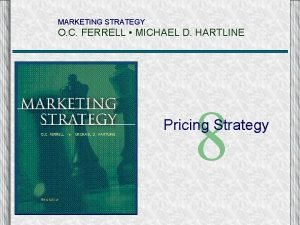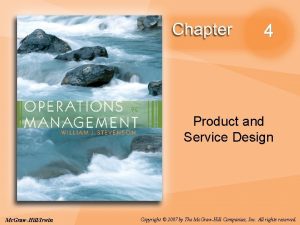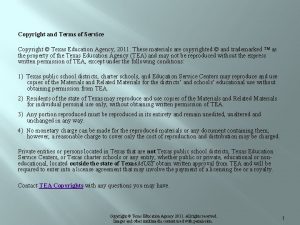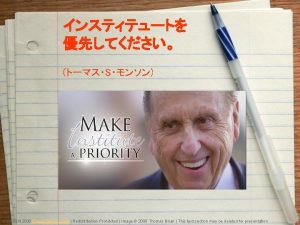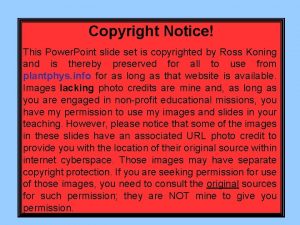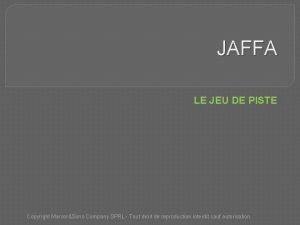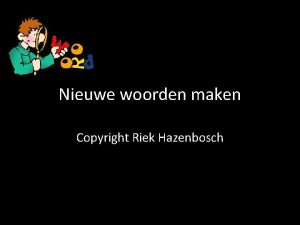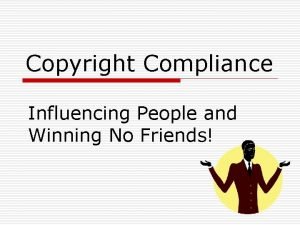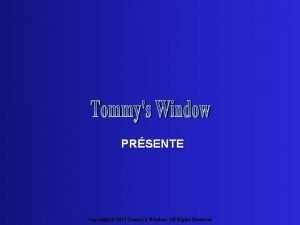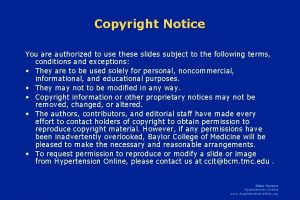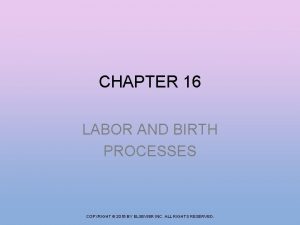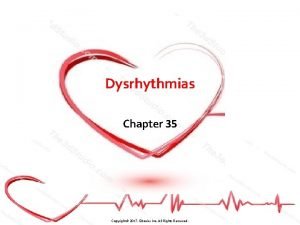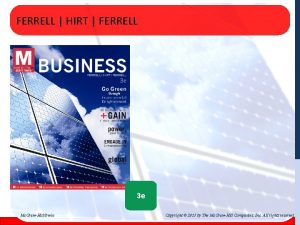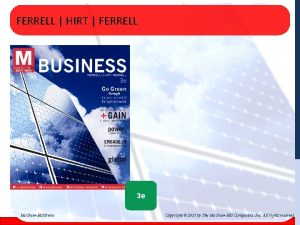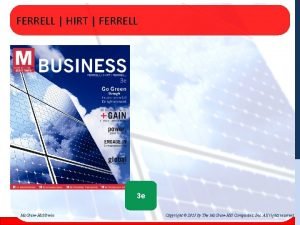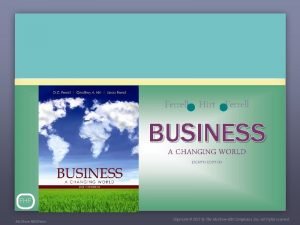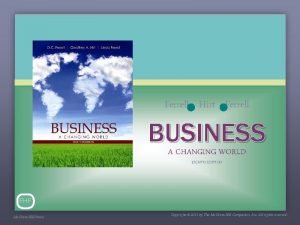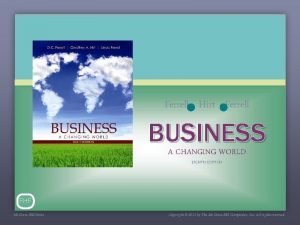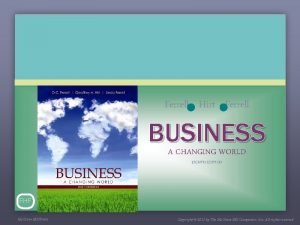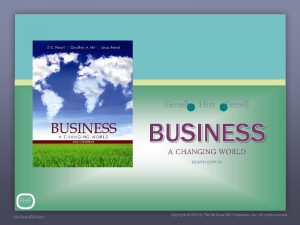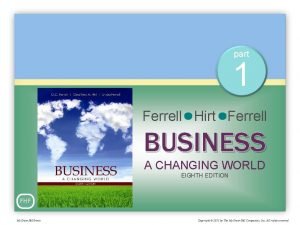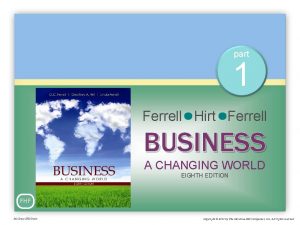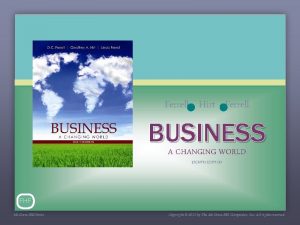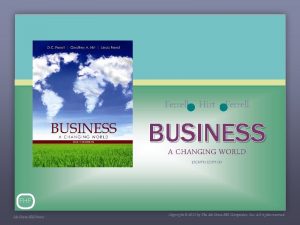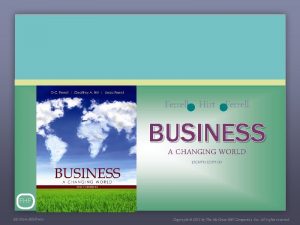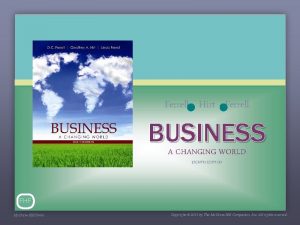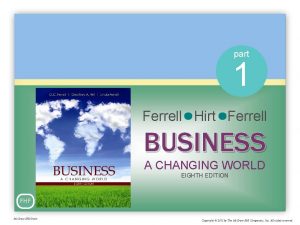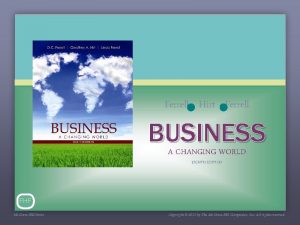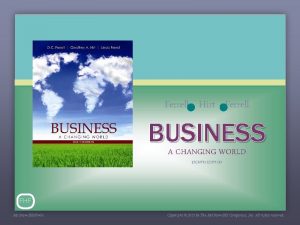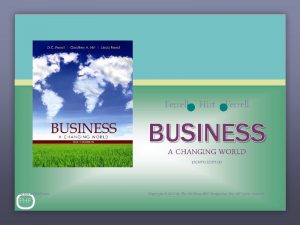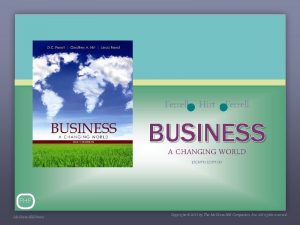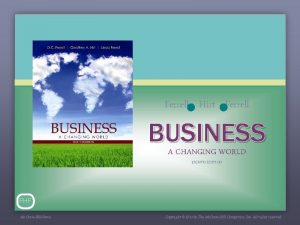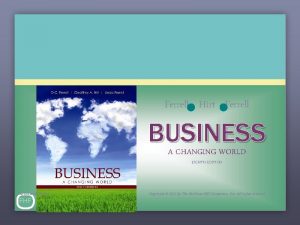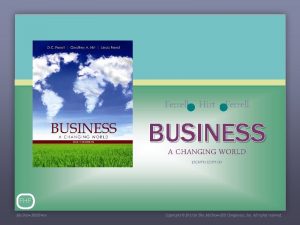FERRELL HIRT FERRELL 3 e Mc GrawHillIrwin Copyright




























- Slides: 28

FERRELL | HIRT | FERRELL 3 e Mc. Graw-Hill/Irwin Copyright © 2013 by The Mc. Graw-Hill Companies, Inc. All rights reserved.

PART 2 • CHAPTER 4 Options for Organizing Business • CHAPTER 5 Small Business, Entrepreneurship, and Franchising 5 -2

ENTREPRENEURSHIP The process of creating and managing a business to achieved desired objectives 5 -3

WHAT IS SMALL BUSINESS? § “Smallness” is relative § Small business is any independently owned and operated business, not dominant in its competitive area § Employs less than 500 people 5 -4

IMPACT OF SMALL BUSINESSES 5 -5

SMALL BUSINESSES REPRESENT § 64% of new net jobs, annually, created in the last 15 years § 99. 7% of all businesses employ fewer than 500 people § 89% of businesses employ fewer than 19 people 5 -6

SMALL BUSINESS INNOVATION Small businesses represent 55% of all innovations ü ü ü ü ü Airplane Audio tape recorder Double-knit fabric Fiber-optic examining equipment Heart valve Optical scanner Personal computer Soft contact lenses Zipper … and much more 5 -7

TRAITS OF SUCCESSFUL ENTREPRENEURS 5 -8

POPULAR INDUSTRIES FOR SMALL BUSINESS Especially attractive industries to entrepreneurs: § § Retailing and wholesaling Services Manufacturing High technology 5 -9

RETAILING AND WHOLESALING Selling directly to consumers § § § § Music stores Sporting-goods shops Dry cleaners Boutiques Drugstores Restaurants Hardware stores 5 -10

SERVICES AND MANUFACTURING Services ü Service sector is 80% of U. S. jobs § Attracts individuals whose skills are not required by large firms Manufacturing ü Small manufacturers excel at customization Ø The Malcolm Baldridge National Quality Award rewards innovative small manufacturing firms 5 -11

HIGH TECHNOLOGY Businesses that depend heavily on advanced scientific and engineering knowledge. § 40% of high-tech jobs are with small businesses § The government offers small business grants for high-tech companies 5 -12

SMALL BUSINESS OWNERSHIP Advantages Disadvantages Independence High stress level Costs High failure rate 50% of all new businesses fail within the first 5 years Flexibility Undercapitalization Lack of funds to operate normally Focus Managerial inexperience or incompetence Reputation Inability to cope with growth 5 -13

STARTING A BUSINESS § § Start with a concept or general idea Create a business plan Devise a strategy to guide planning & development Make decisions • Form of ownership • Financing • Acquire existing business or start new business? • Buy a franchise 5 -14

THE BUSINESS PLAN A precise statement of the rationale for the business and a step-by-step explanation of how it will achieve its goals. Acts as a guide and reference document. ü Explanation of the business ü Analysis of competition ü Income/Expense estimates ü http: //smallbusiness. chron. com/different-partsbusiness-plan-2601. html ü http: //dceintrotobusiness. weebly. com/ 5 -15

FORMS OF BUSINESS OWNERSHIP v. Sole Proprietorship v. Partnership v. Corporation 5 -16

FINANCIAL RESOURCES Provide your own personal capital § Cash money § Obtain capital Financing options § Loans § Stocks § Equity financing 5 -17

EQUITY FINANCING Selling or borrowing against the value of an asset such as an (automobile, insurance policy, savings account) to obtain funds to operate a business 5 -18

VENTURE CAPITALISTS Persons/organizations that agree to provide funding for a new business in exchange for an ownership interest or stock. Usually requires a sharing of ownership/control 5 -19

DEBT FINANCING Borrowing financial resources typically from a bank or lending institution– often collateral is needed 5 -20

LINE OF CREDIT An agreement by which a financial institution promises to lend a business a predetermined sum on demand 5 -21

STARTING FROM SCRATCH VS. BUYING AN EXISTING BUSINESS Starting from scratch can be expensive and will require a lot of promotional efforts to familiarize customers with the business § Existing businesses have the advantage of a built-in network of customers, suppliers and distributors § Reduces guesswork § Involves taking on any problems the business already had 5 -22

FRANCHISING A license to sell another’s products or to use another’s name in business, or both Ø Franchiser § The company that sells a franchise Ø Franchisee § The purchaser of a franchise 5 -23

FRANCHISES Advantages Disadvantages Training & support Fees and profit sharing Brand name appeal Standardized operations National advertising Restrictions on purchasing Financial assistance Limited product line Proven products Possible market saturation Greater chance for success Less freedom in decisions 5 -24

HELP FOR SMALL BUSINESS MANAGERS § Organizations and programs exist to help small businesses § Small Business Administration üSmall Business Development Centers üService Corps of Retired Executives üActive Corps of Executives § Small Business Institutes § U. S. and Local Departments of Commerce § Other small businesses 5 -25

THE FUTURE FOR SMALL BUSINESS Demographic Trends ü The Baby Boomers ü Generation Y (Millennials) ü Immigrants and shifting demographics …continued on next page 5 -26

THE FUTURE FOR SMALL BUSINESS Technological & Economic Trends ü Internet usage continues to increase ü Increase in service exports ü Economic turbulence ü Deregulation of the energy market & alternative fuels 5 -27

BIG BUSINESSES ACTING SMALL Common Approaches § Large firms emulate smaller ones to improve bottom line ØDownsizing (Rightsizing) • Acting small from inception – Southwest Airlines ØIntrapreneurs • Individuals in large firms who take responsibility for the development of innovations within the organization 5 -28
 Marketing strategy ferrell
Marketing strategy ferrell Jennifer ferrell insurance agency
Jennifer ferrell insurance agency Syrgkanis
Syrgkanis Mc copyright
Mc copyright Copyright
Copyright 2008 pearson education inc
2008 pearson education inc Copyright
Copyright Copyright
Copyright Copyright search
Copyright search Copyright pearson education inc
Copyright pearson education inc Redistribution prohibited
Redistribution prohibited Copyright
Copyright Copyright notice on powerpoint slides
Copyright notice on powerpoint slides Head injury nursing management
Head injury nursing management Sponge choanocytes
Sponge choanocytes Copyright
Copyright Nieuwe woorden maken
Nieuwe woorden maken Copyright 2001
Copyright 2001 [email protected]
[email protected] Copyright 2012
Copyright 2012 Copyright notice
Copyright notice Confidential copyright
Confidential copyright Copyright
Copyright Copyright
Copyright Copyright
Copyright Copyright
Copyright Hs and ts
Hs and ts Copyright 1999
Copyright 1999 Max ehrmann desiderata copyright 1952
Max ehrmann desiderata copyright 1952
